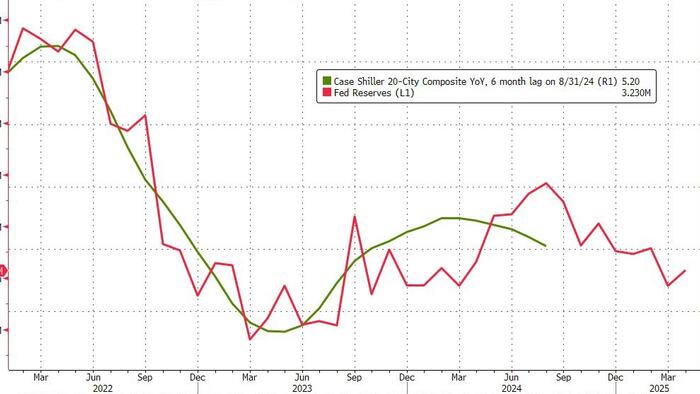The current state of the housing market is increasingly precarious as mortgage rates are re-accelerating, exacerbating an existing affordability crisis that was initially triggered by the Federal Reserve’s rate cuts. Recent data from S&P CoreLogic’s Case-Shiller Index for August reveals that home prices in the top 20 U.S. cities rose by 0.35% month-over-month, which surpassed the anticipated 0.20%. While this uptick signifies persistent demand, it also masks a concerning trend: year-over-year growth in home prices has declined to 5.2%, down from 5.93% in July. This marks the fifth consecutive month of slowing annual growth rates, indicating a potential normalization in what has been a previously heated market. Despite these increasing prices, homes remain near record highs, prompting concerns over housing affordability.
The deceleration in home price growth may offer a glimmer of hope for prospective homebuyers already grappling with unaffordable listings. A slowing appreciation rate could suggest that the market may start to stabilize, easing competition in the housing landscape. However, the correlation of home price appreciation to the Federal Reserve’s bank reserves presents an intriguing dynamic, as historically lower reserves tend to lead to lower home price increases, albeit with a lag. The paradox arises with the Fed’s recent decision to cut interest rates; an action often expected to stimulate buyer activity by making borrowing cheaper. Yet, the timing of these cuts may conflict with the market’s current conditions, which are already showing signs of cooling.
While initial decreases in mortgage rates gave a hint of optimism, recent trends show them climbing back above 7.00%. This resurgence of mortgage rates complicates the affordability narrative further, as higher rates translate to increased monthly payments, which can price out even more potential homebuyers. The fluctuation of mortgage rates has far-reaching implications for both buyers and sellers, affecting everything from purchase decisions to the overall prices in the market. Higher mortgage rates often lead to a decrease in buyer demand, potentially pushing home prices down in the long run.
Experts are beginning to question whether the Fed’s current monetary policy might reignite a housing bubble akin to the one experienced in the 1970s, during which inflation surged alongside escalating home prices. Many fear that repeated reductions in interest rates could result in a renewed surge in home prices, leading to further inflationary pressures. This scenario poses risks not only for the housing market but for the economy as a whole, as a resurgence in housing costs could adversely affect consumer spending and overall economic growth. The specter of the 1970s looms large, where loose monetary policy and rising inflation created a challenging economic environment.
Additionally, the combination of stagnant wage growth and surging housing costs is creating a perfect storm for many Americans. As affordability continues to be a primary concern, potential buyers are increasingly feeling the squeeze, leading to a potential slowdown in home sales. The ongoing challenges faced by first-time homebuyers, in particular, are noteworthy. With many being unable to enter the market, there could be long-term implications for homeownership rates and overall economic stability. The growing disparity between demand and affordability may lead to further imbalances in the market, resulting in a potential bubble scenario.
In conclusion, the present housing market is a reflection of complex and interwoven economic factors. As mortgage rates pressure affordability and home prices remain high, the role of the Federal Reserve in this scenario cannot be understated. The decisions made by the Fed, alongside fluctuations in economic indicators, will be critical in shaping the future of the housing market. A delicate balance must be struck to avoid reigniting a housing bubble while managing inflationary pressures. As the market evolves, stakeholders, from policymakers to potential homeowners, will need to navigate these turbulent waters with caution.

